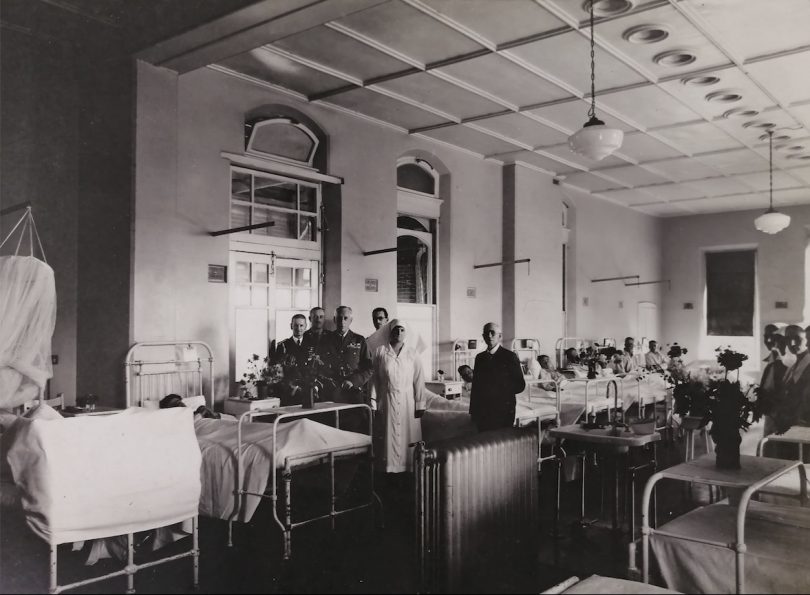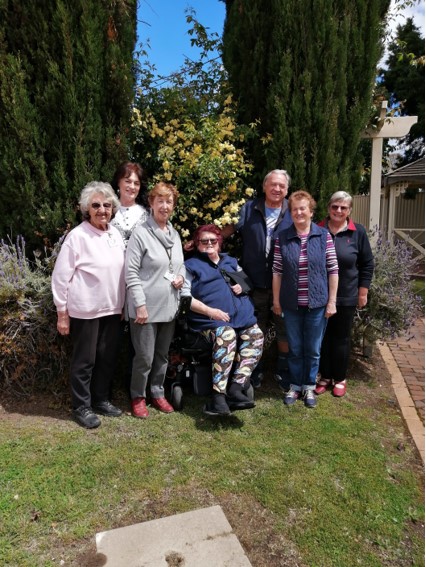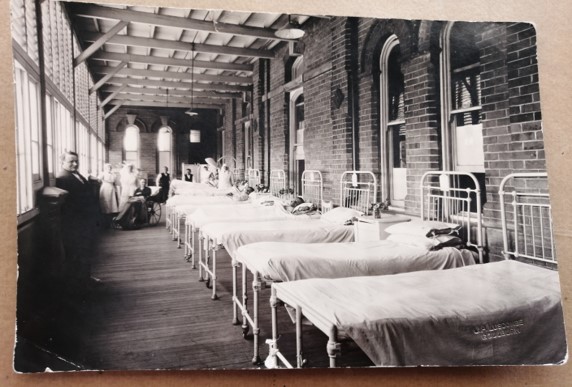
Goulburn Base Hospital’s male ward, sometime in the 1930s. The officers are visiting soldiers injured in a motor vehicle accident. Photo: Supplied by Marlene Eggleston.
Thanks to keyhole surgery, gruesome surgical instruments of earlier times are a distant memory. However, history volunteers are now cataloguing items of interest from Goulburn Base Hospital, and they have discovered some explicit reminders.
Two of the Goulburn Hospital Historical Cataloguing Volunteer Group volunteers, Judy Fowler and Jenny Sullivan, came across redundant gynaecology, theatre and mortuary instruments and syringes.
“I said to Jenny that the ones for the maternity ward, if you were lying in your bed and a nurse come in with one of those instruments, you’d jump straight out of bed,” laughs Judy.
Volunteer Sue Loader – a nurse for 45 years on all the Goulburn Base Hospital wards, including as nurse unit manager on the medical ward – is helping identify the instruments, as are former nurses and volunteers Lorraine Emerton and Marlene Eggleston.
“I remember six months training at Royal Prince Alfred Hospital in Sydney, and I was the only one in our group who had actually done a theatre term,” says Sue.
“They were talking about using these old guillotines for removing tonsils. I put up my hand and said we still do that in Goulburn. That was in about 1975 – they are really barbaric.”
Bob and Gwen McLaren are also volunteers.
Jenny finds the stories about the hospital’s matrons fascinating. Hilda Uhr was matron from 1922 to 1928.
“A year after Matron Uhr’s death, staff took up a collection and commissioned a mahogany grandfather clock, which stood in the hospital foyer with a gold plate,” she says.
“On the bottom right-hand side of the face should have been a little in-memoriam plaque, but it’s not there – just the four little screw marks. We think it dropped down into the workings of the clock.”
Another reminder of Hilda Uhr is a lectern at St Saviour’s Cathedral, which is inscribed in her memory.

Volunteers from Goulburn Hospital Historical Cataloguing Volunteer Group who are identifying and cataloguing Goulburn’s early hospital history. From left: Marlene Eggleston, Gwen McLaren, Judy Fowler, Lorraine Emerton, Bob McLaren, Sue Loader and Jenny Sullivan. Photo: Supplied.
A nurse for almost 40 years, Marlene Eggleston is providing invaluable knowledge. She has donated Matron Ros Noakes’s tablecloth, which was presented on her retirement in 1983. It has the hospital’s emblem and signatures of staff, which she began to embroider. Now a sewing group is finishing embroidery of the signatures.
Goulburn Base Hospital has also been the site of unspeakable tragedy throughout its history.
Matron Eloise Jeffrey-Brown was attacked in her room in the early 1970s, and the director of nursing from 1985 to 1990, Maree Books, was tragically killed in a car accident.
Ruth Stevenson was the longest-serving matron. She began in Goulburn in 1923 and finished in 1962. She was matron for 26 of those years.
Judy Fowler began working in the hospital’s administration office in the 1960s.
“I worked for the secretary at the time, Frank Jennings,” she says. “When people came to visit, the tearoom ladies would come in with big trays of beautiful sandwiches and homemade cakes.

Patients who recovered sufficiently in the Main Ward were then relocated to the verandah, which was later enclosed because of Goulburn’s winters. Matron Stevenson is at the rear of the photograph. The verandah is now part of the intensive care unit. Photo: Supplied by Marlene Eggleston.
“I remember when Mr John Crawford came, he was the first surgeon to come with the title ‘Mr’.
“I had a lot of dealing with Dr Alan Hazelton, who was running the blood bank and pathology.
“Dr Joseph Woods and Dr Peter Little were the visiting GPs.”
Sue says the Goulburn Hospital Historical Cataloguing Volunteer Group volunteers have so far listed more than 5000 items.
She says during an earlier era, about 36 maternity hospitals were in Goulburn. They were one or two rooms attached to a home.
Marlene says she was born in Nurse Guthrie’s, next door to where she is now living.
Sue’s goal is to write detailed captions for the many historic photographs, which she hopes will be accessible on a computer.
Jenny says the volunteers began their work from outside of the hospital buildings, giving items such as the foundation stone, rose garden, pavers and seats with names of donors a number and description for cataloguing, and identifying anything of value.
Inside the hospital, upon opening cupboards they found salt and pepper shakers, cutlery and crockery from when the hospital had a kitchen and staff.
The collection will be moved into a new permanent location as part of Goulburn Base Hospital’s redevelopment.












